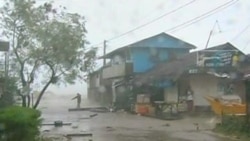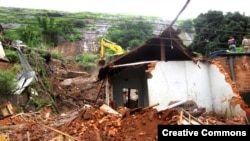The year 2012 was one of extreme weather: massive floods in Australia stranded entire towns; a day of torrential rains submerged half the Philippines capital; a super-typhoon ravaged the western Pacific; and a record drought seared more than half the continental United States.
These and other extreme weather events in 2012 were consistent with what most scientists predict will be the “new normal” as the world’s climate continues to warm.
Disaster strikes
In early December, disaster struck in the Philippines. Typhoon Bopha triggered flash floods and landslides,displacing millions of people. Julius Julian Ribukas survived but much of his family did not.
“My mother and older brother were swept away by flood water," Ribukas said. "That was the last time I saw them."
That disaster echoed a similar calamity a month earlier on the other side of the world, when the largest Atlantic hurricane on record swept up the US East Coast, from Florida to Maine.
Hurricane Sandy’s rains and storm surge ravaged New Jersey coastal communities and inundated New York City’s subways, tunnels and streets, causing more than $40 billion in damage.
New York Governor Andrew Cuomo told reporters that the weather woes are a sign of the times.
“Climate change is a reality," Cuomo said. "It's undeniable that the frequency of extreme weather conditions is up and we're gong to have to learn from that.”
Global climate trends
Hurricane Sandy and Typhoon Bopha fit into the larger global climate trends, says Todd Sanford, a climate scientist with the advocacy group, the Union of Concerned Scientists.
“Basically, if we look at numerous types of climate indicators, they are all moving in the directions that we would expect from an overall warming planet," Sanford said. "So, not only are air temperatures going up, sea surface temperatures are going up, but the heat content of the ocean is going up. Ice is declining, glaciers are retreating.”
Reports from the United Nations and World Bank find the planet is on track to warm between three and five degrees Celsius this century unless heat-trapping emissions from industries, vehicles and buildings are cut significantly.
World Bank Vice President Rachel Kyte paints a grim picture of a planet that grows four degrees hotter over the next century.
“So whether it’s droughts, or storms or sea surges, we’re past the point of climate being something that happens to somebody else in the future," Kyte said. "Climate change is happening to me now.”
Slowing the pace
The World Bank report joins a chorus of voices urging steps to curb human carbon emissions, and slow the pace of climate change.
At a scientific meeting in Washington, WHO senior scientist Diarmid Campbell-Lendrum warned that medical conditions which already kill millions, such as malnutrition, diarrhea and malaria, will only get worse in a warmer world.
“Climate change will tend to increase public health threats and it doesn’t increase them in isolation. It interacts with other factors as well," said Campbell-Lendrum. "So it depends very much where you live, how poor you are. But in general, climate change tends to increase existing threats and increase instability in the system and threaten public health security.”
The year 2012 saw evidence of global warming: accelerating polar ice sheet melting, coral reefs dying and species facing extinction, on land and sea.
For 12 days in December at the United Nations climate talks in Doha, Qatar, delegates from nearly 200 countries met to craft a new treaty to curb industrial emissions and slow climate change.
Policy analyst Jennifer Haverkamp, with the Environmental Defense Fund, was among the thousands of non-governmental observers at the meeting.
She says Doha moved negotiations forward, a bit. “My take-away from Doha is that as important as this meeting is, it’s not the only forum where we’re trying to make progress.”
Promising global initiatives
Haverkamp applauds two promising global initiatives.
One, by a UN group, hopes to reduce emissions from aircraft. If international aviation were a country, its emissions would place it as the world’s 7th largest emitter of climate-changing carbon. The other initiative comes from a coalition of developed and developing nations who want to reduce short-lived air pollutants like methane, soot and refrigerant gases.
Haverkamp adds that some countries are also stepping forward with national plans.
“Just in this past year, we saw Korea pass a climate law, Australia put into place their price on carbon, Mexico pass a climate law," she said. "Kazakhstan is going to take on an emissions trading system."
Haverkamp says these plans stand as an example that all nations can follow as they work to limit their emissions, and prepare for the challenges of a warmer world.
These and other extreme weather events in 2012 were consistent with what most scientists predict will be the “new normal” as the world’s climate continues to warm.
Disaster strikes
In early December, disaster struck in the Philippines. Typhoon Bopha triggered flash floods and landslides,displacing millions of people. Julius Julian Ribukas survived but much of his family did not.
“My mother and older brother were swept away by flood water," Ribukas said. "That was the last time I saw them."
That disaster echoed a similar calamity a month earlier on the other side of the world, when the largest Atlantic hurricane on record swept up the US East Coast, from Florida to Maine.
Hurricane Sandy’s rains and storm surge ravaged New Jersey coastal communities and inundated New York City’s subways, tunnels and streets, causing more than $40 billion in damage.
New York Governor Andrew Cuomo told reporters that the weather woes are a sign of the times.
“Climate change is a reality," Cuomo said. "It's undeniable that the frequency of extreme weather conditions is up and we're gong to have to learn from that.”
Global climate trends
Hurricane Sandy and Typhoon Bopha fit into the larger global climate trends, says Todd Sanford, a climate scientist with the advocacy group, the Union of Concerned Scientists.
“Basically, if we look at numerous types of climate indicators, they are all moving in the directions that we would expect from an overall warming planet," Sanford said. "So, not only are air temperatures going up, sea surface temperatures are going up, but the heat content of the ocean is going up. Ice is declining, glaciers are retreating.”
Reports from the United Nations and World Bank find the planet is on track to warm between three and five degrees Celsius this century unless heat-trapping emissions from industries, vehicles and buildings are cut significantly.
World Bank Vice President Rachel Kyte paints a grim picture of a planet that grows four degrees hotter over the next century.
“So whether it’s droughts, or storms or sea surges, we’re past the point of climate being something that happens to somebody else in the future," Kyte said. "Climate change is happening to me now.”
Slowing the pace
The World Bank report joins a chorus of voices urging steps to curb human carbon emissions, and slow the pace of climate change.
At a scientific meeting in Washington, WHO senior scientist Diarmid Campbell-Lendrum warned that medical conditions which already kill millions, such as malnutrition, diarrhea and malaria, will only get worse in a warmer world.
“Climate change will tend to increase public health threats and it doesn’t increase them in isolation. It interacts with other factors as well," said Campbell-Lendrum. "So it depends very much where you live, how poor you are. But in general, climate change tends to increase existing threats and increase instability in the system and threaten public health security.”
The year 2012 saw evidence of global warming: accelerating polar ice sheet melting, coral reefs dying and species facing extinction, on land and sea.
For 12 days in December at the United Nations climate talks in Doha, Qatar, delegates from nearly 200 countries met to craft a new treaty to curb industrial emissions and slow climate change.
Policy analyst Jennifer Haverkamp, with the Environmental Defense Fund, was among the thousands of non-governmental observers at the meeting.
She says Doha moved negotiations forward, a bit. “My take-away from Doha is that as important as this meeting is, it’s not the only forum where we’re trying to make progress.”
Promising global initiatives
Haverkamp applauds two promising global initiatives.
One, by a UN group, hopes to reduce emissions from aircraft. If international aviation were a country, its emissions would place it as the world’s 7th largest emitter of climate-changing carbon. The other initiative comes from a coalition of developed and developing nations who want to reduce short-lived air pollutants like methane, soot and refrigerant gases.
Haverkamp adds that some countries are also stepping forward with national plans.
“Just in this past year, we saw Korea pass a climate law, Australia put into place their price on carbon, Mexico pass a climate law," she said. "Kazakhstan is going to take on an emissions trading system."
Haverkamp says these plans stand as an example that all nations can follow as they work to limit their emissions, and prepare for the challenges of a warmer world.










